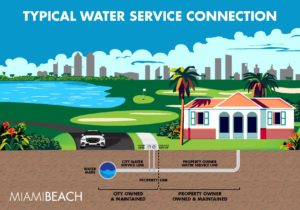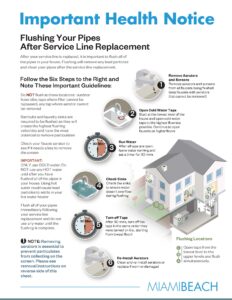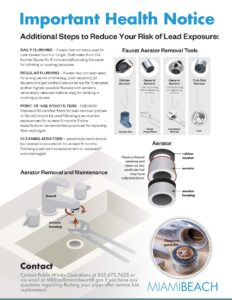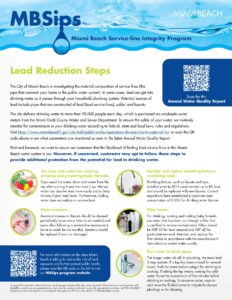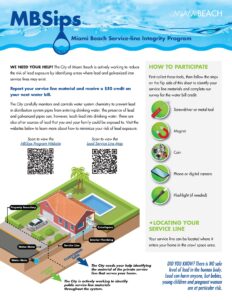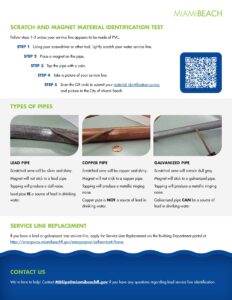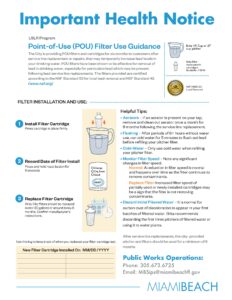Service-Line Integrity Program
The Environmental Protection Agency (EPA) passed the Lead and Copper Rule Revisions (LCRR) effective December 16, 2021 with a compliance deadline of October 16, 2024. The LCRR main goal is to further reduce the risk of lead exposure in all communities within the United States. The LCRR main components include the development of a water service line inventory, lead service line replacement plan, and an updated compliance sample plan which includes schools and childcare facilities. The water service line inventory includes both public and private side and shall be made available to the public via a website. Identifying out-of-date materials, including lead, is the first step toward eliminating them from the distribution system. More information can be found below.
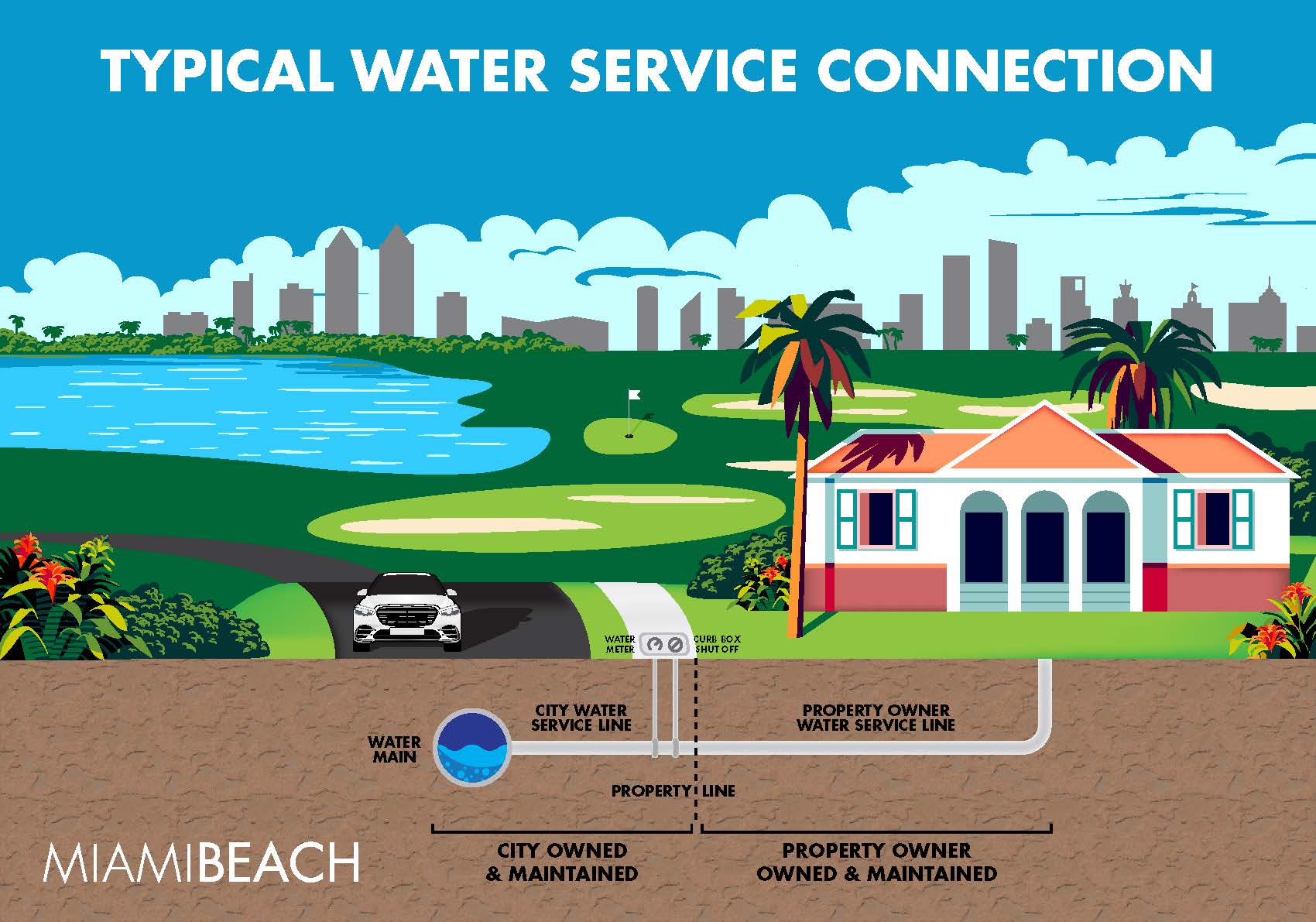
Project Updates
Frequently Asked Questions (FAQs)
What is the Service-line Integrity Program (SIP)?
The Service-line Integrity Program (SIP) is the City’s Water Service Line Program. This program has been developed to identify service line materials in the City’s service area.
What is a water service line?
A service line is the underground pipe that connects your home to the City’s water main. The water service line is located within Public Property / Right of Way (ROW) and in your private property. The water utility owns the utility owned portion of the service line and the customer owns the customer owned portion of the service line. See diagram of water service line (below) location for reference.
Where can I locate my service line?
It can typically be seen where it enters your home in the crawl space or just outside building or house.
Do the revisions to the Lead and Copper Rule mean I have lead pipes?
No. Click here to view the City's Water Service Line Inventory Map web page. A primary purpose of the revisions to the United States Environmental Protection Agency (USEPA) Lead and Copper Rule is simply to identify the material of all water service lines to enhance customer awareness. Identifying out-of-date materials, including lead, is the first step toward eliminating them from the distribution system.
The ultimate goal of the lead and copper rule update is to replace all service lines that are lead or galvanized requiring replacement in both the ROW and private property.
Will this program affect my water bill?
No. The program does not impact the cost of water.
Can I find my service line material information on an inventory from another site other than the Lead Service Line Inventory Map website?
City of Miami Beach customers should be aware that other sources of service line materials, including maps or inventories on other sites, could use outdated and incorrect information. The inventory on the City of Miami Beach website is the most accurate representation of service line material data in the City of Miami Beach distribution system.
How does lead get into drinking water?
Lead is seldom found as a natural contaminant in drinking water and generally originates from lead-based plumbing materials. Lead can enter drinking water when plumbing materials containing lead corrode over time. These materials include pipes made of lead, lead-based solder used to join copper pipe, and brass and chrome-plated brass faucets. Lead service lines are typically the most significant source of lead in the water. In Florida, these materials are more likely to be found in homes built before 1991.
For Health Effect of Exposure to Lead in Drinking Water click here
If a service line constructed with lead is identified on my property and then replaced, how can you ensure there is no longer lead in my water?
Following replacement, residents can request water quality tap sampling between 3 to 6 months after replacement to ensure lead levels are below 10 parts per billion (ppb).
If there are lead-based materials in my service line or premise plumbing, what steps can I take to reduce lead exposure?
Refer to the Lead Reduction Steps flyer for information on steps that can be completed to reduce lead exposure.
Do all lead service lines contaminate drinking water?
Not necessarily. All lead service lines have the potential to leach (release) lead into drinking water, but the City carefully manages the water chemistry in the distribution system to prevent this. The City also operates an EPA approved corrosion control procedure (addition of a corrosion inhibitor to the water entering the distribution system), which forms a protective layer on the pipe to help prevent the release of lead. Lead leaching can occur when an EPA approved corrosion control procedure is not used or optimized, which can result in the corrosion of distribution system materials and release of lead.
If a service line constructed with lead is identified on my property and then replaced, how can you ensure there is no longer lead in my water?
Following replacement, water quality sampling will be conducted to ensure lead levels are below 10 parts per billion (ppb). As an additional protective measure, customers will receive a point of use pitcher filter that is certified for lead and particulate removal and flushing instructions for residents to perform inside the homes to be done after service line replacement. Flushing of the line will also be done in the ROW after each replacement performed in the ROW.
If there are lead-based materials in my service line or premise plumbing, what steps can I take to reduce lead exposure?
The following link includes information on steps that can be completed to reduce lead exposure.
Why is it necessary for me to self-report the material of my service line?
The portion of the water service line between your water meter and your home was not installed by the City. That portion of the water service line was likely constructed in accordance with Florida Plumbing Requirements, which as of 1990 did not include lead as an approved service line material. The Lead and Copper Rule Revision requires an inventory of the entire service line, including the portion owned by the customer. By validating the material of your service line, you are helping to comply with the regulation as well as identifying any outdated service line materials.
Are all residential, commercial, and industrial property owners being asked to complete the survey?
No, only locations where the service line material is still unknown are asked to complete the survey.
How do I know if my service line material is unknown or needs confirmation?
The City is reaching out and sending letters to those customers where service line material is unknown. Service line material can be seen in the Water Service Line Inventory Map web page.
How do I determine what material my water service line is made of?
Instructions for identifying your service line material can be found here: Service Line Material Identification
What will the City do with the survey results?
The City will validate the service line material self-reported by the resident. Validated service line material information will be added to the inventory submitted to the Florida Department of Environmental Protection (FDEP), as required by the USEPA. Service lines constructed of outdated materials will be flagged for replacement.
Will my personal information be shared?
No. Personal information will not be shared. Only public information regarding your service line material will be published to the Water Service Line Inventory Map web page and submitted to EPD, as required by the USEPA. This information includes the verified service line material, date of construction, and physical address. Responses will only be used for the purpose of complying with the Lead and Copper Rule Revisions.
Can I find my service line material information on an inventory from another site other than the Water Service Line Inventory Map website?
City of Miami Beach customers should be aware that other sources of service line materials, including maps or inventories on other sites, could use outdated and incorrect information. The inventory on the City of Miami Beach website is the most accurate representation of service line material data in the City of Miami Beach distribution system.
Will my water service line need to be replaced?
Replacement is only necessary if one of the following conditions are met:
- The service line was constructed with lead
- The service line is galvanized (Galvanized service lines are steel pipes that have been dipped in a protective zinc coating to prevent corrosion and rust) and downstream (the piping entering a customers property) of a service line with unknown material
- If the service line is galvanized and is either currently, or was previously, downstream (the piping entering a customers property) of a lead service line.
Do all galvanized water service lines need to be replaced?
No. Only galvanized service lines that are downstream of a service line of unknown material, or galvanized lines that are currently or were previously downstream of a lead service line will need to be replaced.
Will I get a fine from the City, County or State if I don’t replace the lead and galvanized pipe in my property?
No, you will not be fined. Click here for basic Information about Lead in Drinking Water
Can I replace the service line myself?
Yes, the resident/customer can replace the service line themselves using a certified plumber and appropriate building permits. Resident/customer need to report the service line replacement along with new service line material by email to MBSips@miamibeachfl.gov or via link within 24 hours of replacing the pipe. Email shall have customer/owner name and address for which the service line was replaced.
Advanced Environmental Laboratories, Inc.
6681 Southpoint Parkway
Jacksonville, FL 32216
(904) 363-9350
Eurofins Orlando
481 Newburyport Avenue
Altamonte Springs, FL 32701
(407) 339-5984
Pace Analytical Services, LLC
8 East Tower Circle
Ormond Beach, FL 32174
(386) 672-5668
The Watershed Laboratories, Inc.
304 South Spring Garden Ave.
Deland, FL 32720
(386) 736-3397
Benchmark EnviroAnalytical, Inc.
1711 12th Street East
Palmetto, FL 34221
(941) 723-9986
Florida Spectrum Environmental Services, Inc.
1460 West McNab Road
Ft. Lauderdale, FL 33309
(954) 978-6400
Jupiter Environmental Laboratories
150 South Old Dixie Hwy
Jupiter, FL 33458
(561) 575-0030
EMSL Analytical, Inc.
3303 Parkway Center Court
Orlando, FL 32808
(407) 599-5887
Priority Lab
3301 NW 55th Street
Ft. Lauderdale, FL 33309
(888) 854-0477
MB Sips Flyers
Project Staff
Department Lead
Public Works
Interim Department Director
Bradford Kaine
City Engineer
Cristina Ortega, P.E.
Regulatory Compliance Manager
Patricia Rendon, P.E.
Neighborhood Affairs Director
Kevin Pulido
KevinPulido@miamibeachfl.gov
Consultant
Hazen and Sawyer
Request More Information
Last Updated
September 2024


 83°
83° 